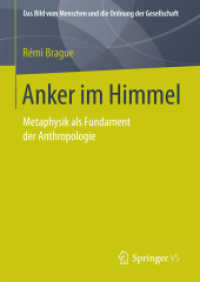Full Description
Throughout this book, readers are presented with agency/organizational analyses using a conceptual framework that is tied to a theoretical perspective about the desired outcomes. This framework provides the coherence for the book and assists individuals with the "mechanics" of writing and challenges them to understand why a particular strategy and with what desired and measurable outcome are they seeking. The book also conveys the "new grantsmanship" which is essential for navigating the economic, political, and social dimensions of proposal and grant writing. The Fourth Edition is expanded and reorganized to follow greater coherence and logic in the presentation of the chapters. The new sections are:@!fundamentals of proposal writing@!the three lenses of proposal @!conceptualization@!writing the proposal.
Contents
Table of ContentsTitle PageDedicationList of FiguresList of TablesPreface to the Fourth EditionChapter One: An Orientation to Proposal WritingA. A Book for the Beginning Grant WriterB. A Brief History of Giving and PhilanthropyC. About the Non-Profit AgencyD. Differences between Grants and ContractsE. Funding Sources and Guidelines for Grants and Contracts* Governmental versus Foundation ApplicationsF. The Proposal Submission and Scoring Processes* Proposal ScoringChapter Two: Organizing the Writing and Using TechnologyA. The Nuts and Bolts of Writing a ProposalB. Writing for an Established versus New Organization* Writing for an Established OrganizationC. Writing Style and FormatD. The Components of the ProposalE. Using Techology* The Role and Use of Search Engines* Review of Funders' Websites* Assessing Data* Electronic Submission of the ProposalChapter Three: Assessing the OrganizationA. Mission-Driven Analysis of the OrganizationB. Organizational Capacity* Survey of the OrganizationC. The Agency Capability Statement* Sample Applicant Capability Statement* Supportive DocumentationD. Working with a CollaborativeE. Writing a Proposal for a Collaborative* Determine the Need and Establish Goals* Explore Potential Program Offerings and Benefits* Develop the Final Program Concept and BudgetChapter Four: Generating and Refining Proposal IdeasA. Understanding the Community* Analyzing the Community through Data- Client/Community Needs Assessment- City, County, and State Demographic Data- Journal Articles- Local NewspapersB. Problem or Needs-Based Program IdeasC. Understanding Barriers in Program Design* Barriers to ServiceD. Agency Capacity and Sustainability* Sustainability: Determining Income Generating Potential* The Life Cycle of a Project* Multi-Source FundingE. Formulating Program IdeasF. Applying the Logic ModelChapter Five: Writing the Needs/Problem StatementA. The Goal of the Need StatementB. A Guide to Writing the Need Statement* The Nature and Extent of the Need/Problem* Factors Contributing to the Problem or Conditions* Impact of the Need/Problem* Promising Approaches for Improved ResultsChapter Six: Writing Goals, Objectives, and the Implementation PlanSection One: Goals and ObjectivesA. Program GoalsB. Formulating ObjectivesC. Types of Objectives* Process Objectives* Outcome ObjectivesSection Two: Implementation PlanA. Developing the Implementation Plan* Inputs - Resources/Preparatory Activities* Process or Program-Related Activities* Outputs/Units of ServiceB. Writing the Project NarrativeC. Scope of WorkD. Project TimelineChapter Seven: Writing the Evaluation PlanA. The Benefits of Evaluation* Funder's Perspective* Organization's PerspectiveB. Developing an Evaluation PlanC. Using the Logic ModelD. Process EvaluationE. Outcome EvaluationF. Writing the Evaluation SectionG. Other Evaluation ConsiderationsChapter Eight: Creating the BudgetA. The Budget ContextB. Preparation of a Line Item BudgetC. Other Types of Budgets* Matching Funds and In-Kind BudgetsD. Other Budgeting Issues* Budget Adjustment* Budget Amendment* Contract Negotiations and SubcontractingChapter Nine: Finishing TouchesA. Requesting Letters of SupportB. Proposal AbstractC. Title and Title PageD. Cover LetterAppendix A: Estimating TimeAppendix B: Funding Resource InformationReferences and Suggested ReadingsIndexAbout the Authors








